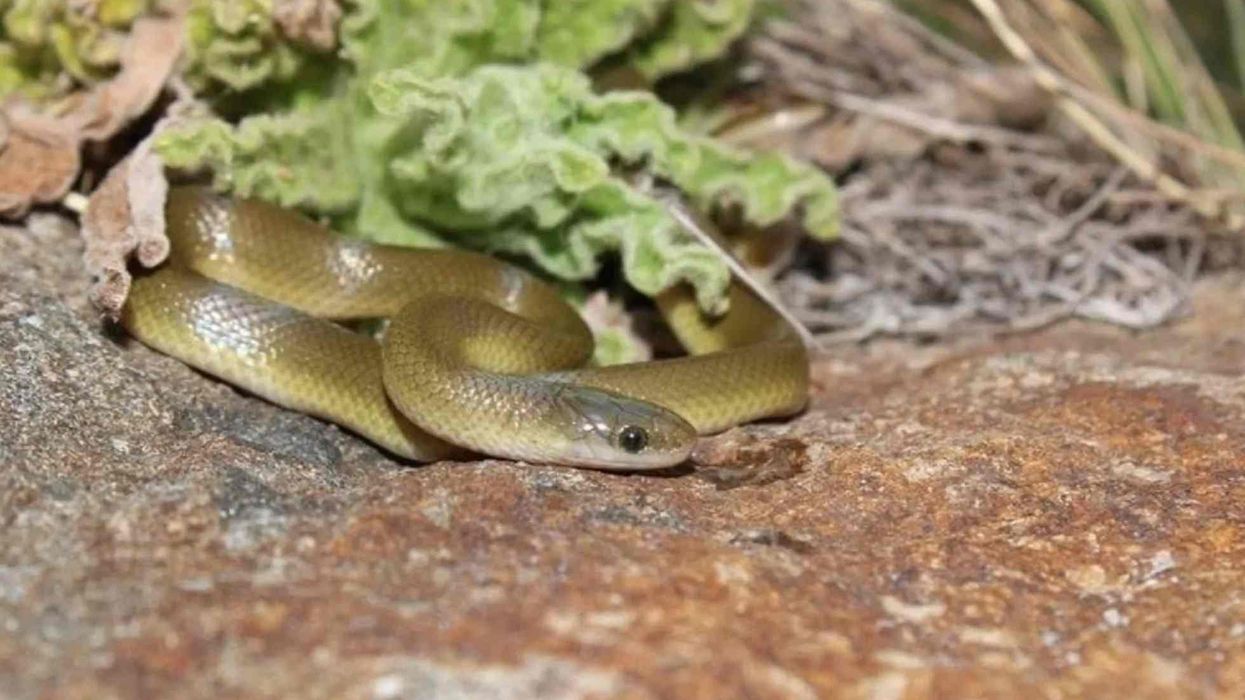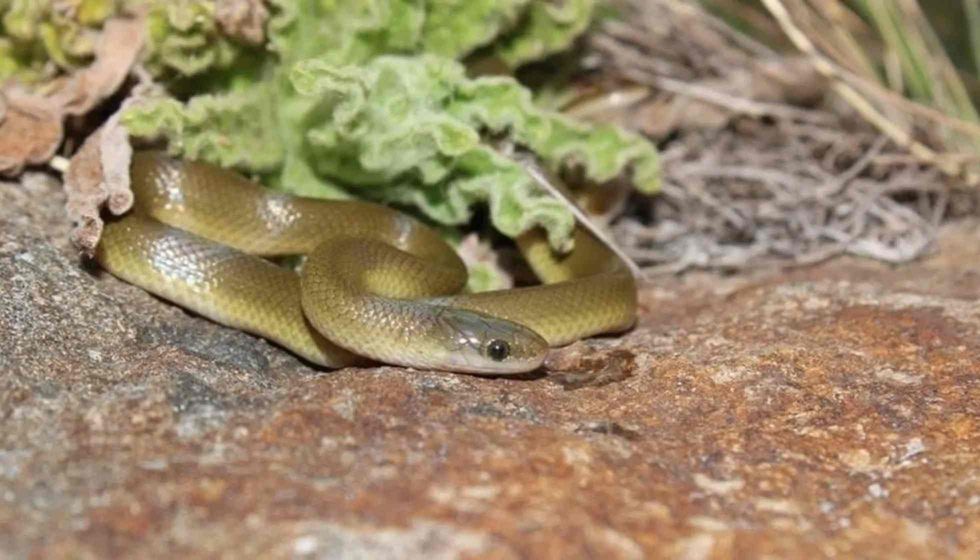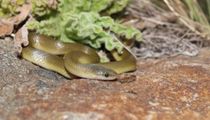Fun African House Snake Facts For Kids
The Lamprophis is a genus of medium-sized non-venomous snakes commonly called African house snakes. This genus has several species of snakes that exhibit diversity in color, patterns, and size.
The African house snake is found in a variety of habitats such as scrublands, grasslands, wetlands, and near inland water bodies, savannahs, deserts, and tropical forests. The house snake derives its name from living near human houses and settlements to prey on the rodents that feed on human waste.
While rodents are its main diet, the African house snake also feeds on lizards and small birds. These snakes are popular in the exotic pet trade and are easy to care for and breed in captivity.
African house snakes are not poisonous and aggressive towards humans. They are generally nervous and skittish in nature and tend to flee in response to a perceived threat.
You may also check out rat snake facts and snake facts from Kidadl.
African House Snake Interesting Facts
What type of animal is an African house snake?
Lamprophis is a genus of medium-sized non-venomous species of snakes. The common name of the Lamprophis is the African house snake.
These include Abyssinian house snake, Aurora house snake, Ethiopian house snake, Fisk’s house snake, yellow-bellied house snake, Seychelles house snake, and Spotted house snake. Boaedon fuliginosus is a species in the family Lamprophiidae. Its common name is the brown African house snake.
What class of animal does an African house snake belong to?
Lamprophis, or African house snakes, is a genus of several species of house snakes belonging to the family Lamprophiidae and class Reptilia in the Animalia kingdom.
How many African house snakes are there in the world?
The population of African house snakes in the world is not documented.
Where does an African house snake live?
African house snakes are found all over sub-Saharan Africa in the heat and warm temperature range. There are several species of Lamprophis, commonly called African house snake, that are spread across different countries in the range of the African continent.
The Boaedon fuliginosus, brown house snake is a species in the family Lamprophiidae commonly found in West Africa.
These house snakes are highly adaptable and derive their name from dwelling around human habitats range as they prey upon the rodents that thrive in human waste. They are found in a wide variety of warm habitats such as scrublands, wetlands, grasslands, montane regions, savannahs, and tropical and sub-tropical forests.
What is an African house snake's habitat?
There is great diversity in the habitat of the African house snake. House snakes are a genus of several species of snakes inhabiting a wide variety of warm temperature habitats in sub-Saharan Africa.
These snakes are commonly found in scrubland, grasslands, and mountainous regions, savannahs and desert habitats with heat, inland wetlands as well as tropical forests. Depending on the species, African house snakes have adapted to temperature and living conditions in the ecosystems of the desert, dense scrub, wetland, savannah, and tropical forest.
African house snakes have also adapted to live around human dwellings and temperature in these habitats. They are commonly found around human villages as they prey on the rats and rodents that feed on human waste.
Who do African house snakes live with?
African house snakes are found to live alone in burrows around human dwellings and settlements or in their natural habitats. However, when breeding in captivity, African house snakes may be kept alone or in groups in enclosures under warm temperatures and the right substrate.
How long does an African house snake live?
African house snakes have an average lifespan of 15 years in the wild. They can live up to 20 years in captivity or as a pet.
How do they reproduce?
African house snakes are oviparous animals. Females lay clutches of about 8-12 eggs. The eggs hatch after about two months of incubation. African house snake hatchlings can measure up to 8 in (20cm) in length.
House snakes are prolific breeders. In captivity, female house snakes may lay a clutch of around nine to 16 eggs in early spring.
What is their conservation status?
Excluding the Seychelles house snake, the conservation status of all of the other reptile species of house snake is of Least Concern. Their populations are stable are they face no immediate and grave threat to their numbers.
The Seychelles house snake is an endangered species of the Lamprophis. Endemic to the Seychelle islands, this house snake is threatened by habitat loss of tropical forests and wetlands. Its current population is decreasing and efforts are in place to conserve the African house snake species.
African House Snake Fun Facts
What do African house snakes look like?

These snakes are slender snakes of medium length with diversity in patterns found across the species. Their color ranges from light to dark brown and black with faint patterns of spots or stripes.
The Lamprophis or Boaedon fuliginosus with the common name brown African house snake is a common exotic pet. It is known for its distinctive brown slender body with white stripes on either side of the head near its eyes. In all species of African house snakes, females are larger than males.
How cute are they?
While snakes may make for unusual pets, they are loved and adored by reptile lovers. African house snake care is relatively easy. They make for great pets for beginners and you may consider them cute if you are not afraid of them! Their colors, patterns, slender bodies, and bright eyes make them look very elegant and graceful.
How do they communicate?
Like most snakes, house snakes are solitary reptile creatures and have limited communication with other snakes. House snakes use chemical cues such as pheromones to communicate and receive information about their environment.
They have a well-developed sense of taste and smell. Their vomeronasal system allows them to collect pheromones from their environment using their bifurcated tongue and process them through organs in the roof of their mouth. Snakes communicate for the purposes of breeding, mating, and defending their territory or food source.
How big is an African house snake?
African house snake size varies in length. Generally, females are larger than males. In the natural world, females of the different species of this reptile can grow anywhere between 47-59 in (120-150 cm).
Males are smaller and can grow up to 30 in (76 cm). In captivity, female house snakes are found to grow up to 59 in (150 cm). A female adult house snake is about four to five times smaller in body size than a Burmese python.
How fast can an African house snake move?
African house snakes move quickly with great speed and agility. They have a swift striking force, although they bite very rarely. Their first defensive reaction is to feel quickly. Young hatchlings and young adults can be nippy. They move very quickly and must be handled with care in an enclosure.
How much does an African house snake weigh?
An adult female African house snake can weigh up to 0.55-1.1 lb (0.25-0.50 kg), adult male house snakes may weigh up to 0.55 lb (0.25 kg).
What are the male and female names of the species?
The males and females of the species of the genus Lamprophis, common name African house snake do not have separate names. However, males and females exhibit sexual dimorphism. This means that they have different physical characteristics in addition to different primary sex organs. Female house snakes are significantly larger and weigh more than male house snakes.
What would you call a baby African house snake?
A baby African house snake is called a hatchling. In the natural world, house snake hatchlings can measure up to 8 in (20 cm) in length. However, when breeding in captivity or as a pet, house snake hatchlings measure about 5-7 in (13-18 cm) in length upon hatching.
What do they eat?
In their natural habitats, African house snakes' diet consists of rodents, lizards, geckos, and small birds and bats. In captivity or when kept as pets, house snakes can be fed a diet of rodents, rats, pinkie mice, and lizards.
House snake hatchlings may be given small mice, lizards, and gecko tails as food. Adult house snakes must be fed once a week. Adult snakes must be fed separately if you have more than one house snake.
This is because adult African house snakes have a violent feeding response. This can lead to cannibalism if they compete for food.
Are they poisonous?
No, African house snakes are a genus of non-venomous snakes commonly found in sub-Saharan Africa. There are several species of house snakes, they are not poisonous.
Would they make a good pet?
African house snakes are a popular pet in the exotic pet trade. The Boaedon fuliginosus or the brown African house snake is a common exotic pet. African house snake care is easy.
They make for a good pet for beginners who like reptiles and are fond of exotic pets. These snakes may be kept in a warm enclosure with a natural substrate and low humidity. House snakes prefer warmth and low humidity of around 30-50%.
Soil or sand may be used as a substrate in the enclosure. As the substrate is dry, a separate space with moss will help maintain humidity. This will also help your snake to shed its skin on the substrate in the enclosure.
Heat may be provided using a heat bulb or a heat map. The temperature must be regulated using a thermostat to ensure optimal temperatures for your pet.
The temperatures of the basking area and cool moist areas must be around 90 F (32 C) and 70 F (21 C) respectively. At night, the temperature can be lowered to about 41 F (5 C).
African house snakes have skittish and nervous temperaments. They must be handled slowly with patience. If you have African house snakes as pets, you must also feed them separately. They have a violent feeding response that can lead to cannibalism. Hence, pet snakes must have separate enclosures for feeding.
Did you know...
The African house snake derives its name from living near human houses and dwellings to prey on the rodents and rats that feed on human waste.
Adult female house snakes can store sperm in their bodies and can lay between five to six clutches of eggs in a year just from one mating cycle!
Breeding African house snakes
Breeding African house snakes in captivity is easy and requires little care. You will require an adult mature male and female snake. African house snakes must not be bred until the male reached 0.33 lb (0.15 kg) or more and the female reaches between 0.55-0.66 lb (0.25-0.3 kg).
This may take around two years. Once the snakes are mature, the male house snake may be introduced to the female’s enclosure. They will twitch, chase each other and intertwine their bodies to mate.
Females will shed their skin about 50-55 days after conceiving. They will lay their eggs after about 7-10 days of this pre-lay shedding of skin.
Each clutch may have about 8-12 eggs on average, with as few as five or as many as 20 eggs. The incubation period for house snake eggs is between 60-80 days. Females must be provided a large box with moss to lay and incubate their eggs.
Otherwise, they will lay their eggs in the water bowl and the eggs will be lost. Incubation is ideal between temperatures of 75-85 F (24-30 C) and 70% humidity.
Hatchlings and young adults must be fed separately because of their strong and frenzied feeding response.
Do African house snakes bite?
African house snakes are found to be nervous creatures in the wild. They are non-venomous and do not bite.
Here at Kidadl, we have carefully created lots of interesting family-friendly animal facts for everyone to discover! For more relatable content, check out these Burmese python facts and king cobra facts for kids.
You can even occupy yourself at home by coloring in one of our free printable African house snake coloring pages.
We Want Your Photos!
More for You
Bachelor of Arts specializing in Linguistics

Martha MartinsBachelor of Arts specializing in Linguistics
Martha is a full-time creative writer, content strategist, and aspiring screenwriter who communicates complex thoughts and ideas effectively. She has completed her Bachelor's in Linguistics from Nasarawa State University. As an enthusiast of public relations and communication, Martha is well-prepared to substantially impact your organization as your next content writer and strategist. Her dedication to her craft and commitment to delivering high-quality work enables her to create compelling content that resonates with audiences.
Disclaimer
1) Kidadl is independent and to make our service free to you the reader we are supported by advertising. We hope you love our recommendations for products and services! What we suggest is selected independently by the Kidadl team. If you purchase using the Buy Now button we may earn a small commission. This does not influence our choices. Prices are correct and items are available at the time the article was published but we cannot guarantee that on the time of reading. Please note that Kidadl is a participant in the Amazon Services LLC Associates Program, an affiliate advertising program designed to provide a means for sites to earn advertising fees by advertising and linking to Amazon. We also link to other websites, but are not responsible for their content.
2) At Kidadl, we strive to recommend the very best activities and events. We will always aim to give you accurate information at the date of publication - however, information does change, so it’s important you do your own research, double-check and make the decision that is right for your family. We recognise that not all activities and ideas are appropriate for all children and families or in all circumstances. Our recommended activities are based on age but these are a guide. We recommend that these ideas are used as inspiration, that ideas are undertaken with appropriate adult supervision, and that each adult uses their own discretion and knowledge of their children to consider the safety and suitability. Kidadl cannot accept liability for the execution of these ideas, and parental supervision is advised at all times, as safety is paramount. Anyone using the information provided by Kidadl does so at their own risk and we can not accept liability if things go wrong.
3) Because we are an educational resource, we have quotes and facts about a range of historical and modern figures. We do not endorse the actions of or rhetoric of all the people included in these collections, but we think they are important for growing minds to learn about under the guidance of parents or guardians.




